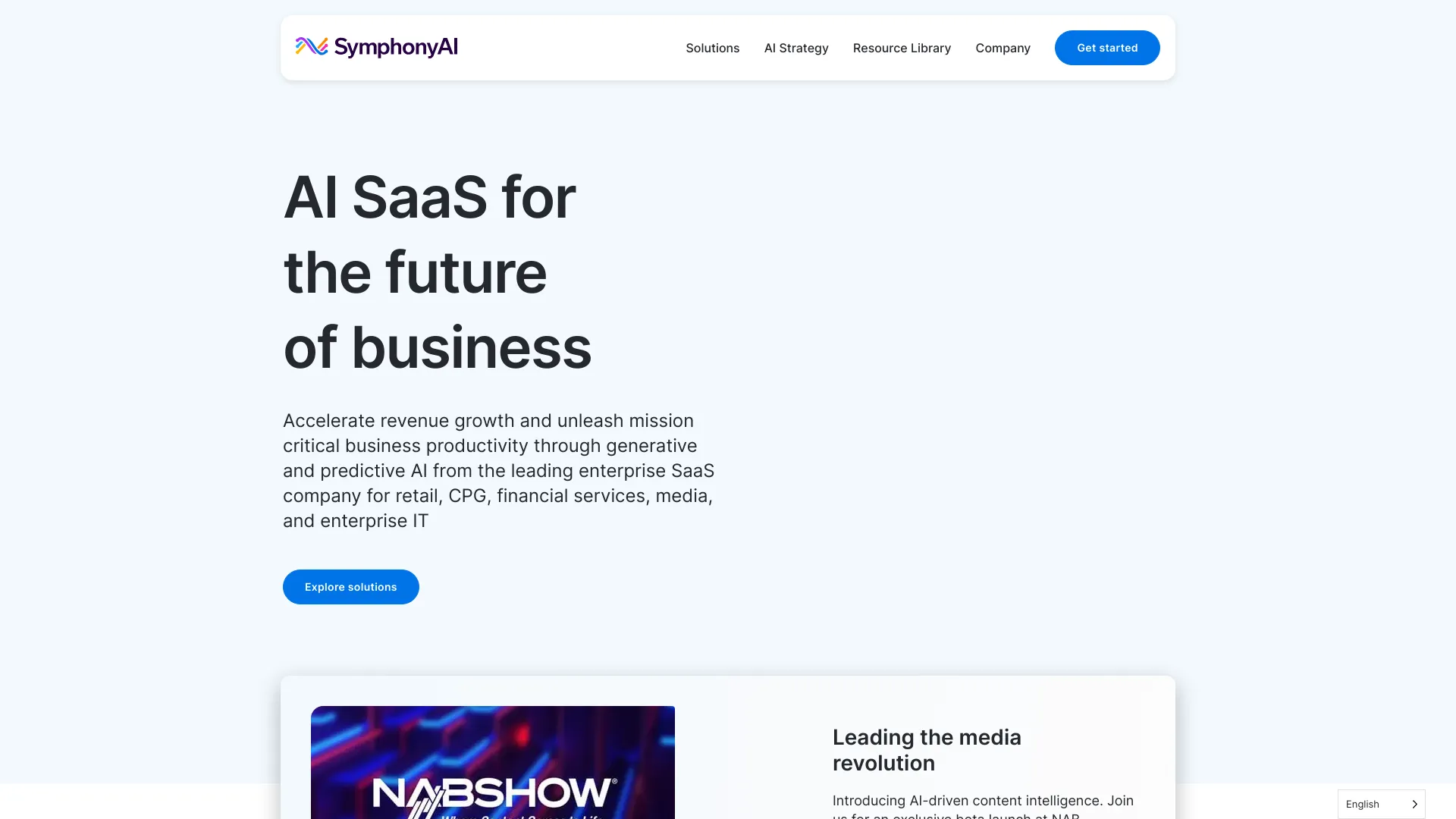- Home
- AI For Finance
- SymphonyAI

SymphonyAI
Open Website-
Tool Introduction:Ready-to-deploy, industry AI uniting predictive, generative, agentic.
-
Inclusion Date:Nov 08, 2025
-
Social Media & Email:
Tool Information
What is SymphonyAI
SymphonyAI is a suite of industry-specific AI applications that combine predictive, generative, and agentic AI to deliver ready-to-deploy solutions for enterprise outcomes. It accelerates decisions, automates workflows, and surfaces actionable insights across Retail CPG, Financial Services, Industrial operations, Enterprise IT, Media, and Trading & Investing. With prebuilt models, domain logic, and data connectors, SymphonyAI helps organizations move from pilots to production faster while maintaining governance, security, and measurable business impact.
Main Features of SymphonyAI
- Predictive analytics: Forecast demand, detect anomalies, and anticipate risk using domain-tuned machine learning.
- Generative AI copilots: Natural language interfaces for search, insight generation, and report drafting to speed decision-making.
- Agentic workflows: Autonomous agents that execute multi-step tasks, trigger actions, and orchestrate end-to-end processes.
- Industry-specific apps: Prebuilt solutions for Retail CPG, Finance, Industrial, IT, Media, and Trading & Investing to reduce time-to-value.
- Computer vision and NLP: Visual inspection, document understanding, and unstructured data extraction at scale.
- Data integration: Connectors for ERP, CRM, POS, IoT, market data, and data lakes with secure ingestion and transformation.
- Dashboards and decision intelligence: Role-based KPIs, what-if simulation, and root-cause analysis.
- Governance and security: Access controls, auditability, model monitoring, and responsible AI practices.
Who Can Use SymphonyAI
SymphonyAI serves enterprise teams that need measurable outcomes from AI. Typical users include retail merchandisers and supply chain planners, risk and fraud analysts in financial services, plant and quality managers in industrial operations, IT operations and service management teams, media operations and content teams, and trading, research, and compliance functions. Business leaders, data scientists, and analysts use it to operationalize AI with minimal lift.
How to Use SymphonyAI
- Define the business objective and select the relevant industry application or module.
- Connect data sources (e.g., ERP, POS, IoT, market feeds) via built-in connectors or APIs.
- Configure domain settings, KPIs, and policies; map entities and data quality rules.
- Calibrate models using historical data; fine-tune prompts and agent workflows.
- Validate results in a pilot environment with stakeholder feedback and A/B testing.
- Deploy to production with role-based dashboards, alerts, and automated actions.
- Monitor performance, drift, and governance metrics; retrain and iterate as needed.
- Scale to additional use cases and integrate with existing enterprise systems.
SymphonyAI Use Cases
Retail CPG: demand forecasting, price and promotion optimization, inventory and shelf analytics. Financial services: fraud detection, AML alert triage, credit risk scoring, customer intelligence. Industrial: predictive maintenance, quality inspection with computer vision, energy optimization, safety monitoring. Enterprise IT: AIOps incident prediction, root-cause analysis, ticket automation. Media: content metadata enrichment, rights and compliance checks, audience analytics. Trading & Investing: signal generation support, anomaly detection, research copilots.
SymphonyAI Pricing
SymphonyAI typically follows an enterprise licensing model with modular applications and deployment-based pricing. Organizations can request a demo, scope a pilot or proof of value, and receive a tailored quote based on users, data scale, and use cases. Subscription options and cloud or hybrid deployments are commonly supported; contact the vendor’s sales team for current packages and commercial terms.
Pros and Cons of SymphonyAI
Pros:
- Domain-specific applications that reduce time-to-value.
- Combines predictive, generative, and agentic AI for end-to-end automation.
- Strong integration layer and role-based decision dashboards.
- Governance, security, and monitoring built for enterprise standards.
- Scalable from pilot to production across multiple business lines.
Cons:
- Enterprise implementation may require change management and data readiness.
- Custom configuration and integration can extend timelines.
- Pricing and packaging are typically tailored, which may not suit smaller teams.
- Performance depends on data quality and ongoing model maintenance.
FAQs about SymphonyAI
Is SymphonyAI a platform or a set of applications?
It provides a suite of industry-specific applications built on a common AI platform and integration layer.
What types of AI does SymphonyAI use?
It combines predictive models, generative AI copilots, and agentic automation to deliver outcomes.
How long does deployment take?
Timelines vary by use case and data readiness; many teams start with a pilot before scaling to production.
Can it integrate with existing systems?
Yes, it offers connectors and APIs for common enterprise systems, data lakes, and IoT sources.
Does it support governance and compliance?
It includes access controls, auditability, and model monitoring to support responsible AI practices.

